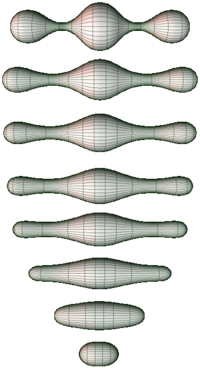
Back Ricci-Fluss German Flujo de Ricci Spanish شار ریچی Persian Programme de Hamilton French Alir Ricci ID リッチフロー Japanese Ricci-stroom Dutch Поток Риччи Russian Ricci flow SIMPLE Daloy Ricci Tagalog

In the mathematical fields of differential geometry and geometric analysis, the Ricci flow (/ˈriːtʃi/ REE-chee, Italian: [ˈrittʃi]), sometimes also referred to as Hamilton's Ricci flow, is a certain partial differential equation for a Riemannian metric. It is often said to be analogous to the diffusion of heat and the heat equation, due to formal similarities in the mathematical structure of the equation. However, it is nonlinear and exhibits many phenomena not present in the study of the heat equation.
The Ricci flow, so named for the presence of the Ricci tensor in its definition, was introduced by Richard Hamilton, who used it through the 1980s to prove striking new results in Riemannian geometry. Later extensions of Hamilton's methods by various authors resulted in new applications to geometry, including the resolution of the differentiable sphere conjecture by Simon Brendle and Richard Schoen.
Following the possibility that the singularities of solutions of the Ricci flow could identify the topological data predicted by William Thurston's geometrization conjecture, Hamilton produced a number of results in the 1990s which were directed towards the conjecture's resolution. In 2002 and 2003, Grigori Perelman presented a number of fundamental new results about the Ricci flow, including a novel variant of some technical aspects of Hamilton's program. Perelman's work is now widely regarded as forming the proof of the Thurston conjecture and the Poincaré conjecture, regarded as a special case of the former. It should be emphasized that the Poincare conjecture has been a well-known open problem in the field of geometric topology since 1904. These results by Hamilton and Perelman are considered as a milestone in the fields of geometry and topology.
© MMXXIII Rich X Search. We shall prevail. All rights reserved. Rich X Search